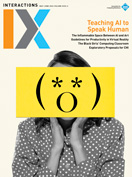Authors:
Miriam Sturdee
Text version
I call Eric from my kitchen table, and seconds into the interview one of my cats decides he wants to be in on the action. Crawling up onto my shoulder and then trying to sit on the laptop, he breaks the ice. Eric is in a room with a rack of stringed instruments behind him—mandolin and guitar! It is impossible not to ask about them first…but we soon get into chatting about his work at Roblox and the creator economy.
I believe that one of the most interesting shifts in design and HCI is that we’re now building systems for creators that allow for the emergence of behaviors, design, and novel experiences—rather than just crafting a specific product.
It’s amazing to see kids are now able to create an immersive, virtual environment on their own using these new ecosystems. My 7-year-old can go in and grab 3D models, drag them into the scene and move them around, and then press Publish and suddenly he’s sharing his game with his friends.
I have heard of Roblox; my friend’s kids are always playing it. One made a cityscape where he was flying around with a jetpack and I was mesmerized.
It may be threatening for some who are attached to the idea of professional creation…but it’s also opening a field for creators that didn’t exist when I was young!
I totally get this. There are so many artists in uproar because of people using generative AI instead of their services—it’s been a huge disruption. I can also appreciate how much fun it must be for kids, though, and even adults, to have the ability to make something which previously took major skills and learning to achieve.
One of the challenges is that it’s fun to drag stuff into the scene—but then it’s difficult to go into the next level of depth of interaction. People hit that wall: “Oh I have to write some code” That’s what everyone’s trying to figure out: How do you help people through that learning curve?
That’s an interesting point. We aren’t quite there yet where you can create the logic and fancier bits of a game without knowing the process in a deeper way.
One way is to make the tools easier to use and learn. This is where things like Gen AI and no-code/ low-code scripting environment s come into play. But suddenly, you’re removing a bunch of the work of creation, and is that actually interesting? Creators want to have fun while they’re creating, right?
We’re already seeing code assist even in our universities—students can autocomplete, or even generate whole solutions using AI—though they still need to understand the code to be able to implement it properly. I also see people on the Internet having so much fun generating playful images, it’s a new toy, but…
Is it the end product of creation that’s interesting, or is it the process of creation that draws people in and makes them want to do it again and again?
Eric and I talk further about creative process, and about how jamming with other musicians is a wonderful way of making music—it is a collaborative process—and it is the process that is important here. If it is too easy to generate something, where is the joy?
This leaves us with really interesting questions around what creativity is, who is a creative, and what processes and workflows we can enable to end up with outcomes that are good for society.
Perhaps I am biased as an illustrator, but the joy is in the creation, the mark making on paper. It also makes me consider issues of control—we can write a prompt but the results are often variable. For me, I’ll be sticking to pen and paper…but maybe I’ll experiment with the iPad one day.
Miriam Sturdee is a lecturer at the University of St Andrews working on intersections of art, design, and computer science. She is a practicing artist and designer and has an MFA in visual communication. Her publications explore areas of futuring, sketching and drawing, alternative research outputs, and psychology. [email protected]
Copyright held by author
The Digital Library is published by the Association for Computing Machinery. Copyright © 2024 ACM, Inc.








Post Comment
No Comments Found